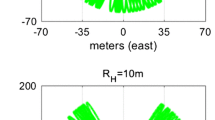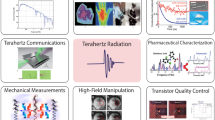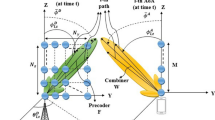Abstract
A new approach for unparallel trajectory bistatic spotlight SAR imaging is proposed. The approach utilizes the concept of instantaneous Doppler wavenumber and introduces two variants, the sum-range and subtraction-range, to develop the 2D frequency analytical formula. Based on the assumption of plane wavefront, the transmitting and receiving Doppler are separated and formulated via series reversion. And frequency scaling is applied to focus image. The algorithm is with high computational efficiency, and provides well focus for limited scene imaging. Simulation result confirms the validity of the approach.
Similar content being viewed by others
References
Neo Y L, Wong F H, Cumming I G. Processing of azimuth-invariant bistatic SAR Data using the range Doppler algorithm. IEEE Trans Geos Remote Sens, 2006, 46(1): 14–21
Zhu Z B, Tang Z Y, Jiang X Z. The chirp scaling algorithm of airborne bistatic SAR imaging. J Electr Inf Tech, 2006, 28(6): 977–81
Soumekh M. Bistatic synthetic aperture radar inversion with application in dynamic object imaging. IEEE Trans Signal Proccess, 1991, 39(9): 2044–2055
He F, Liang D N, Dong Z. A wavenumber domain algorithm for spaceborne bistatic SAR imaging with large squint angle. Acta Electr Sin, 2005, 33(6): 1011–1014
Walterscheid I, Ender J, Brenner A, et al. Bistatic SAR processing and experiments. IEEE Trans Geos Remote Sens, 2006, 44(10): 2710–2717
Ender J, Walterscheid I, Brenner A. Bistatic SAR-translational invariant processing and experimental results. IEE Proc Radar Sonar Navig, 2006, 153(3): 177–183
Zhang Z H, Xing M D, Ding J S, et al. Focusing the parallel bistatic SAR data using the analytic transfer function in wavenumber domain. IEEE Trans Geos Remote Sens, 2007, 45(11): 3633–3645
Loffeld O, Neis H, Peter V, et al. Models and useful relations for bistatic SAR processing. IEEE Trans Geos Remote Sens, 2004, 42(10): 2031–2038
Rigling B D, Moses R L. Polar format algorithm for bistatic SAR. IEEE Trans Aerospace Electr Syst, 2004, 40(4): 1147–1159
Natroshvili K, Loffeld O, Nies H, et al. Focusing of general bistatic SAR configuration data with 2-D inverse scaled FFT. IEEE Trans Geos Remote Sens, 2006, 44(1): 2718–2727
Neo Y L, Wong F, Cumming Ian G. A two-dimensional spectra for bistatic SAR processing using series reversion. IEEE Geos Remote Sens Lett, 2007, 4(1): 93–96
Carrara W G, Goodman R S, Majewski R M. Spotlight Synthetic Aperture Radar: Signal Processing Algorithms. Boston: Artech House, 1995
Mittermayer J, Morerira A A, Loffeld O. Spotlight SAR data processing using the frequency scaling algorithm. IEEE Trans Geos Remote Sens, 1999, 37(5): 2198–2214
Author information
Authors and Affiliations
Corresponding author
Additional information
Supported by the National Natural Science Foundation of China (Grant No. 60502044) and Program for New Century Excellent Talents in University (Grant No. NCET-06-0861)
Rights and permissions
About this article
Cite this article
Zhang, L., Jing, W., Xing, M. et al. Unparallel trajectory bistatic spotlight SAR imaging. Sci. China Ser. F-Inf. Sci. 52, 91–99 (2009). https://doi.org/10.1007/s11432-009-0012-1
Received:
Accepted:
Published:
Issue Date:
DOI: https://doi.org/10.1007/s11432-009-0012-1




